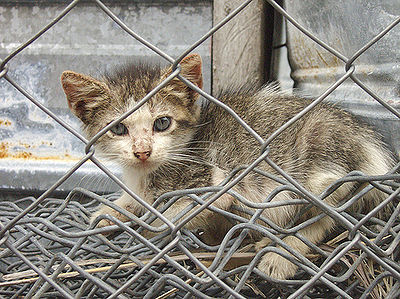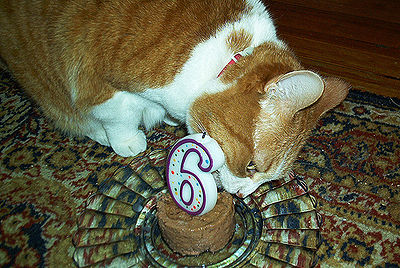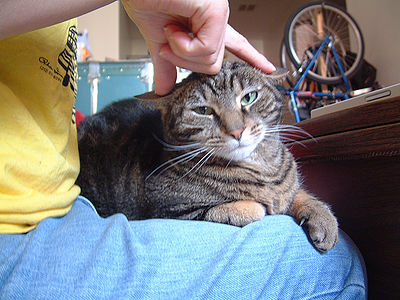
A feral cat is one that has had little or no human contact. Feral cats face all the hazards that accompany living wild outdoors. There were originally abandoned by their families and became what we call strays, to fend for themselves and have learned to mistrust humans. The resulting kittens born into this environment are feral too.
Semi-feral cats are those that have had some human contact and will accept food and may even allow some petting. Sometimes these cats form feral colonies, congregating near food sources. These colonies are breeding grounds for disease. These cats reproduce in great numbers and are good candidates for Trap, Neuter, Release programs.
In some cases feral kittens and cats can become pets. The sad case is that most of them are too frightened to tame. Trying to tame a kitten gives you a better chance at success.
Socialization in kittens is best achieved between 3 and 9 weeks old. As cats get older, it becomes more difficult to socialize them. Although some older cats can be tamed, there are some who will just not bond with humans. Some adult feral cats have had previous contact with humans, making success more likely.
It is best not to attempt to catch a kitten younger than 5 weeks old, since it will still be dependent on its mother’s milk. Use a trap or stout gloves to catch the cat since it will fight back aggressively.
Taming
You can begin by wooing the mother cat with her kittens into a cage where you can place some food. If you can, bring them indoors. If not, but you are able to cage them, they should be examined by a vet and vaccinated as soon as possible. You must tell the vet that these cats are feral as they must be handled very carefully.
Taming takes about 2-6 weeks. It is easiest to tame one cat at a time. If you are attempting to tame a whole litter, work with each one individually.
Keep the cat in a pen in a room where it will see humans frequently. Speak gently to them and move slowly. When you are not in the room, you can leave on a TV or radio to accustom the cat to human voices.
With regular feedings, even feral cats will stay close to the food source. Try staying quietly nearby when feeding them. If you can, make a comfortable place out of harm’s way for the cats to sleep in. Feed them commercial cat food as well as special treats so that they regard you as a food-provider. Don’t try to handle them for the first few days, as this will frighten them. When reaching into the pen, do so with curled fingers since this is less intimidating. Eventually the cat and her kittens will become accustomed to your presence.
Once this happens, using a toy you can control, tempt the kittens to play. The kittens will soon become very curious and if you put a bit of food in your open palm, the bravest one might come to sniff and even eat. Don’t make any sudden moves that will frighten them.
When the kittens are used to being hand-fed, you can try gentle petting. Cats love the back of their necks massaged. Sit near them and eventually they will climb on your lap and might even fall asleep there. If you have more than cat to tame, start with the least aggressive. Stroke the cat from behind so that it doesn’t lash out. Speak calmly while stroking and don’t stare at the cat. If it panics, stop stroking and continue to speak gently. Once the cat starts to purr, it is time to move on to picking up the cat. If you leave your door open the kittens can wander in. Just be sure to confine them to one area and offer some tasty treats.
Grip the cat securely by the scruff, as its mother would, and place it on your lap. Hold it securely, stroking it and talking gently. Don’t hold the cat too loosely or too tightly. If it panics, put it down. Even if the cat allows you to pick it up, keep sessions brief. If the cat objects every time you pick it up, try holding it on your lap in a carrier so that it becomes used to sitting on your lap. If you have other cats in the house, let the feral cats see you petting it.
Next, teach the cat how to play. Use ping-pong balls, fishing-rod style toys and a scratching post to get your cat active. Also, encourage other people to play with and stroke the cat so it gets used to interacting with more than one person.
With patience, the kittens will learn to trust you and decide that living indoors is a good idea. Mother cat may never want to live inside, but it may be advisable to contact a feral cat association in your area and ask for help in trapping mom and having her spayed. She can then be released near your home and you can continue to care for her. Who knows, after gaining her trust, she may decide to be a live-in too.
There are some feral cats that turn out to be untameable. If this is the case, the most humane thing to do is spay or neuter the cat and release it back into the wild. After a few months, if the cat has not bonded with you, it won’t in the future.
Finding the cat a home
Once you have tamed the cat, you may want to find it a new home. It is important to tell the new owners that this is a tamed feral cat so that they know what to expect. It is best not to place a tamed cat in a home with excitable young children. A home with other cats is preferable so it can learn to interact with people from the other cats. If possible, send some familiar objects with the cat to the new home to make adjustment easier.
Adult cats will have a harder time adjusting to a new home than a kitten will. It is probably best to tame an adult cat with the attention of keeping it yourself.
Related articles:



